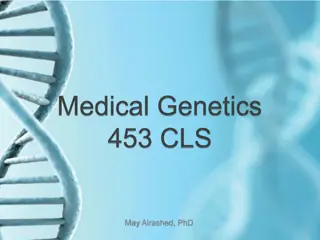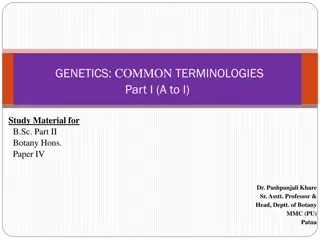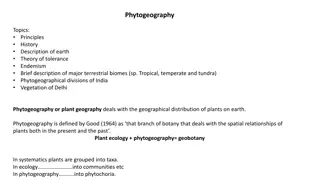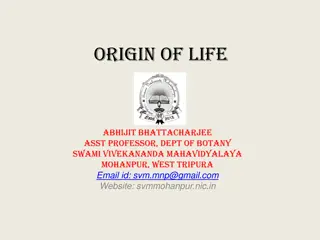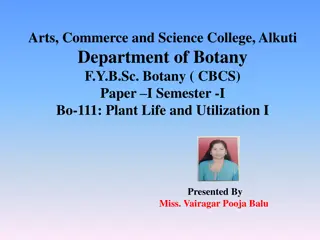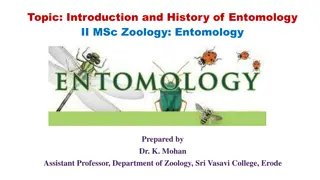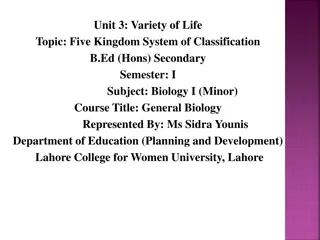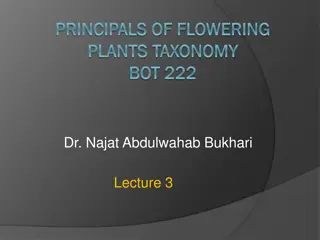Carolus Linnaeus - Father of Modern Botany and his Classification System
Carolus Linnaeus (1707-1778) is known as the Father of Modern Botany for his significant contributions to the field. He developed a systematic way of classifying species, introducing binomial nomenclature. Linnaeus published works like Systema Naturae and Species Plantarum, where he described and classified thousands of plant and animal species. His classification system, including 24 classes based on the number of stamens in flowers, revolutionized taxonomy and is still influential in botanical science today.
Download Presentation

Please find below an Image/Link to download the presentation.
The content on the website is provided AS IS for your information and personal use only. It may not be sold, licensed, or shared on other websites without obtaining consent from the author. Download presentation by click this link. If you encounter any issues during the download, it is possible that the publisher has removed the file from their server.
E N D
Presentation Transcript
Linnaeus System Presented by Dr. R. P. Patil Professor & Head Department of Botany Deogiri College, Aurangabad
Ravi Patil Deogiri College, Aurangabad.
Carolus Linnaeus (1707-1778) He was a Swedish naturalist. For his outstanding contribution he is called the Father of Modern Botany . He published his work in different times since 1730 to final form in 1753. 1. 1730 Hortus Uplandicus (contains the plants of Uppsala Botanic Garden at that time). 2. 1735 Systema Naturae. 3. 1737 Hortus Cliffortianus (contains the plants in the Garden of George Clifford at Hartecamp). 4. 1737 Genera Plantarum. 5. 1738 Classes Plantarum. 6. 1751 philosophia Botanica (contains the revised revision of his earlier publications Systema Naturaeand Classes Plantarum.
During his lifetime, Linnaeus collected around 40,000 specimens of plants, animals, and shells. He believed it was important to have a standard way of grouping and naming species. So in 1735, he published his first edition of Systema Naturae (The System of Nature), which was a small pamphlet explaining his new system of the classification of nature. In total, Linnaeus named 4,400 animal species and 7,700 plant species using his binomial nomenclature system. The tenth edition of Systema Naturae was published in 1758 and is considered the most important edition. Its full title in English is System of nature through the three kingdoms of nature, according to classes, orders, genera and species, with characters, differences, synonyms, places.
7. 1753 Species Plantarum (contains some 7,300 species described and arranged according to his system of classification). In this book, he constantly used the binomial system in plant names. The Binomial system consists of two names of a specimen, where the first one is the generic epithet and the second is the specific epithet. This binomial system was used subsequently, even by the modern botanists till date. The classification of Linnaeus is an artificial one. The significance of flower and fruit structures was first recognised by him. He emphasised the basic numerical characteristics of sexual parts i.e., stamens and carpels. Thus the Linnaeus system is also known as sexual system. Based on the number, size, length and union of stamens, he classified the plant kingdom into 24 classes, such as Monandria (flower with one stamen), Diandria (flower with two stamens), etc. The classes were further divided into orders, based on the number of styles in each flower such as Monogynia (flower with one style), Digynia (flower with two styles) etc.
The outline of Linnaeus System of classification with twenty four (24) classes is given: Classes: 1. Monandria (flowers with 1 stamen). 2. Diandria (flowers with 2 stamens). 3. Triandria (flowers with 3 stamens). 4. Tetrandria (flowers with 4 stamens). 5. Pentrandria (flowers with 5 stamens). 6. Hexandria (flowers with 6 stamens). 7. Heptandria (flowers with 7 stamens). 8. Octandria (flowers with 8 stamens). 9. Enneandria (flowers with 9 stamens). 10. Decandria (flowers with 10 stamens). 11. Dodecandria (flowers with 12 stamens). 12. Icosandria (flowers with more than 20 stamens opp calyx). 13. Polyandria (flowers with more than 20 stamens on receptacle). 14. Didynamia (stamens didynamous). 15. Tetradynamia (stamens tetradynamous). 16. Monadelphia (stamens monadelphous). 17. Diadelphia (stamens diadelphous). 18. Polyadelphia (stamens polyadelphous). 19. Syngenesia (stamens syngenesious). 20. Gynandria (stamens adnate to the pistil). 21. Monoecia (plants monoecious). 22. Dioecia (plants dioecious). 23. Polygamia (plants polygamous). 24. Cryptogamia (non-flowering plants i.e., cryptogams which include algae, fungi, mosses and ferns). Due to simple and convenient approach, the Sexual System became very popular for more than 75 years before the publication of natural system by A. L. de Jussieu and A. P. de Candolle.
Merits and Demerits: Merit: The only merit of this system is the quick and easy identification of plants based on one or a few characteristics. Demerits: 1. The system is not at all sexual in proper sense, but based only on numerical relationship of sex organs. Thus, it can be said that this system was developed on differences rather than on similarities of sex organs. 2. The closely related members go apart and the distantly related members become very close to each other for the numerical relation of the sex organs. 3. The Gymnosperms were placed in the 14th class Didynamia along with Labiatae, an angiosperm family. 4. The Monocotyledons, Dicotyledons and Gymnosperms i.e., phanerogamic plants are not considered separately. Thus, the members of Dicotyledons and Monocotyledons become very close, e.g., i. In the 1st class Monandria (flower having 1 stamen) Globba (Zingiberaceae of Monocotyledons) and Mangifera (Anacardiaceae of Dicotyledons). ii. In the 6th class Hexandria (flowers having 6 stamens) -Alisma (Alismaceae of Monocotyledons) and Rumex (Polygonaceae of Dicotyledons) come very close. Many other examples are also available. 5. Thus it can be said that this classification is just like a dictionary where the words are arranged alphabetically without maintaining any relationship.
Linnaeus returned to Sweden in 1738 and began a medical practice in Stockholm. In 1739 he married Sara Elisabeth. He practiced medicine until the early 1740s but longed to return to his botanical studies. A position became available at Uppsala University, and he received the chair in medicine and botany there in 1742. Linnaeus built his further career upon the foundations he had laid in the Netherlands. He used his international contacts to create a network of correspondents that provided him with seeds and specimens from all over the world. He then incorporated this material into the botanical garden at Uppsala, and these acquisitions helped him develop and refine theempirical basis for revised and enlarged editions of his major taxonomic works. During his lifetime he completed 12 editions of Systema Naturae, 6 editions of Genera Plantarum, 2 editions of Species Plantarum ( Species of Plants, which succeeded the Hortus Cliffortianus in 1753), and a revised edition of Fundamenta Botanica (which was later renamed Philosophia Botanica [1751; Philosophy of Botany ]). Furthermore, all these works appeared in countless pirated versions, translations, and popularadaptations in all major European languages.
Linnaeus had seven children with Sara Elisabeth, but only five survived to adulthood. In the late 1750s he purchased the farms of Hammarby, S vja, and Edeby outside Uppsala, which allowed Linnaeus and his family to spend their summers in the country. In 1761 he was granted a Swedish patent of nobility, from which time he was known as Carl von Linn . After nearly one-third of Uppsala was destroyed by fire in 1766, he established a museum made of stone for his collections on a hill behind Hammarby. A stroke in 1774 left Linnaeus greatly weakened, and he died in 1778. Linnaeus s only son, Carl, became his successor and the custodian of his collections. However, Carl died within a few years, and Sara Elisabeth sold Linnaeus s collections and manuscripts to Sir James Edward Smith, founder of the Linnean Society of London.






